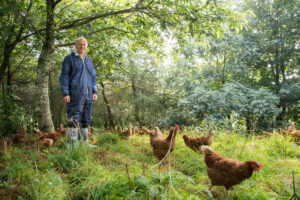Introduction :
A vibrant tapestry of agricultural practices weaves its way through human history, intertwining cultures, ecosystems, and economies. Agriculture, the lifeline of civilizations, has evolved and diversified to meet the needs of a changing world. In this captivating blog post, we embark on an enlightening journey to explore the rich spectrum of agricultural types, unearthing their unique characteristics and unveiling their significance in forging a sustainable future.
I. Embracing Indigenous Wisdom: Agroecology
Deep within the roots of agriculture lie ancient practices that have sustained communities for generations. Agroecology encompasses the wisdom of indigenous peoples, emphasizing a holistic approach to farming that respects the interconnectedness of nature. By employing diverse cropping systems, traditional knowledge, and eco-friendly techniques, agroecology safeguards biodiversity, enhances soil fertility, and fosters resilient farming systems. We delve into the beauty of agroecology, celebrating its profound cultural heritage and its potential to shape sustainable agricultural landscapes.
II. Beyond the Green Revolution: Regenerative Agriculture
In response to the environmental repercussions of industrial agriculture, a growing movement seeks to heal the land and revitalize farming practices. Regenerative agriculture goes beyond sustainability, aiming to restore ecosystems, rebuild soil health, and sequester carbon. Through methods like cover cropping, rotational grazing, and agroforestry, regenerative agriculture rejuvenates the natural balance, fostering thriving habitats, and mitigating climate change. We unravel the transformative power of regenerative practices, illuminating their role in fostering regrowth and revitalization.
III. Innovating for Efficiency: Vertical Farming
Amidst urban landscapes and limited space, a technological revolution is reshaping agriculture’s traditional boundaries. Vertical farming emerges as a pioneering solution, harnessing controlled environments, hydroponics, and artificial lighting to cultivate crops in vertical layers. By maximizing space, reducing water usage, and minimizing transportation distances, vertical farming offers an efficient and sustainable approach to urban food production. We explore the towering potential of vertical farms, unraveling their ability to bring agriculture closer to consumers and invigorate urban landscapes.
IV. Harnessing the Power of Data: Precision Agriculture 2.0
In the era of connectivity and big data, agriculture embraces cutting-edge technologies to optimize resource utilization and increase yields. Precision Agriculture 2.0 harnesses the power of sensors, artificial intelligence, and machine learning to create a data-driven revolution in farming. From autonomous drones mapping fields to AI-powered crop disease diagnostics, this evolving approach empowers farmers to make informed decisions, reduce inputs, and enhance productivity. We unravel the digital tapestry of Precision Agriculture 2.0, exploring its potential to shape a future where efficiency and sustainability converge.
V. Cultivating Connections: Community-Supported Agriculture
In an era of food miles and disconnectedness, Community-Supported Agriculture (CSA) weaves bonds between farmers and consumers, nourishing local communities. CSA creates a direct relationship, where individuals invest in a farm through subscriptions or shares and receive a portion of the harvest. By fostering transparency, supporting small-scale farmers, and promoting local food systems, CSA cultivates a sense of belonging and resilience. We explore the power of CSA to bridge the gap between producers and consumers, forging a path towards a more sustainable and equitable food future.
Conclusion:
The landscape of agriculture is as diverse as the ecosystems it nurtures. By embracing the wisdom of indigenous practices, nurturing regenerative approaches, harnessing innovation, and fostering community connections, we pave the way for a truly sustainable future. As we delve into the intricacies of agroecology, regenerative agriculture, vertical farming,
Multiple Choice Question on Agriculture and Farming:
- Which of the following is a primary sector activity?
a) Manufacturing
b) Services
c) Agriculture
d) Construction
Solution: c) Agriculture
- Which of the following is an example of intensive farming?
a) Organic farming
b) Subsistence farming
c) Vertical farming
d) Extensive farming
Solution: c) Vertical farming
- Which of the following crops is commonly used for animal feed?
a) Wheat
b) Soybeans
c) Rice
d) Corn
Solution: d) Corn
- Which of the following is a non-renewable resource in agriculture?
a) Water
b) Fertilizer
c) Sunlight
d) Soil
Solution: b) Fertilizer
- What is the process of converting saltwater into freshwater called?
a) Desalination
b) Irrigation
c) Aquaculture
d) Photosynthesis
Solution: a) Desalination
- Which of the following is an example of a cash crop?
a) Barley
b) Tomato
c) Lentils
d) Millet
Solution: b) Tomato
- Which of the following farming techniques involves growing crops without soil?
a) Aquaponics
b) Hydroponics
c) Aeroponics
d) Agroforestry
Solution: b) Hydroponics
- Which of the following is an example of a rabi crop?
a) Rice
b) Wheat
c) Maize
d) Sugarcane
Solution: b) Wheat
- Which of the following is a greenhouse gas emitted by livestock?
a) Nitrous oxide
b) Carbon dioxide
c) Methane
d) Ozone
Solution: c) Methane
- Which of the following is a traditional farming method practiced in hilly areas?
a) Terrace farming
b) Drip irrigation
c) Precision farming
d) Greenhouse farming
Solution: a) Terrace farming
- Which of the following is a micronutrient essential for plant growth?
a) Nitrogen
b) Phosphorus
c) Potassium
d) Zinc
Solution: d) Zinc
- Which of the following is a method of weed control in agriculture?
a) Crop rotation
b) Composting
c) Mulching
d) Herbicide application
Solution: d) Herbicide application
- Which of the following is a disease caused by a deficiency of Vitamin C?
a) Beriberi
b) Scurvy
c) Rickets
d) Goiter
Solution: b) Scurvy
- Which of the following is a major source of income for farmers in India?
a) Tourism
b) Remittances
c) Agriculture
d) Mining
Solution: c) Agriculture
- Which of the following is a biological method of pest control?
a) Pesticide spraying
b) Genetic modification
c) Crop rotation
d) Soil erosion
Solution: c) Crop rotation
- Which of the following is an example of a kharif crop?
a) Wheat
b) Mustard
c) Cotton
d) Potato
Solution: c) Cotton
- Which of the following is an example of a kharif crop?
a) Wheat
b) Mustard
c) Cotton
d) Potato
Solution: c) Cotton
- Which of the following is an example of a leguminous crop?
a) Rice
b) Maize
c) Barley
d) Lentils
Solution: d) Lentils
- Which of the following farming practices involves the cultivation of multiple crops in the same field simultaneously?
a) Mixed cropping
b) Monoculture
c) Shifting cultivation
d) Intensive farming
Solution: a) Mixed cropping
- Which of the following is a method of organic farming?
a) Use of chemical pesticides
b) Monocropping
c) Crop rotation
d) Genetic modification
Solution: c) Crop rotation
- Which of the following is a source of renewable energy in agriculture?
a) Fossil fuels
b) Solar power
c) Natural gas
d) Coal
Solution: b) Solar power
- Which of the following is a technique used to conserve water in agriculture?
a) Over-irrigation
b) Furrow irrigation
c) Flood irrigation
d) Drip irrigation
Solution: d) Drip irrigation
- Which of the following is a disease commonly found in cattle?
a) Malaria
b) Tuberculosis
c) Cholera
d) Dengue fever
Solution: b) Tuberculosis
- Which of the following is a method used for seed dispersal in plants?
a) Pollination
b) Fertilization
c) Germination
d) Wind dispersal
Solution: d) Wind dispersal
- Which of the following is an example of a perennial crop?
a) Rice
b) Wheat
c) Sugarcane
d) Maize
Solution: c) Sugarcane
- Which of the following is a technique used to control soil erosion?
a) Overgrazing
b) Deforestation
c) Contour plowing
d) Monoculture
Solution: c) Contour plowing
- Which of the following is a method used for breeding plants with desired traits?
a) Genetic modification
b) Cross-pollination
c) Composting
d) Crop rotation
Solution: b) Cross-pollination
- Which of the following is an example of a farm implement?
a) Tractor
b) Fertilizer
c) Pesticide
d) Greenhouse
Solution: a) Tractor
- Which of the following is a by-product of the dairy industry?
a) Cotton
b) Wool
c) Milk
d) Leather
Solution: c) Milk
- Which of the following is a method of soil conservation?
a) Deforestation
b) Overgrazing
c) Terrace farming
d) Monoculture
Solution: c) Terrace farming
- Which of the following is an example of a cash crop?
a) Potato
b) Rice
c) Millet
d) Tea
Solution: d) Tea
- Which of the following is a method used to control pests in agriculture?
a) Crop rotation
b) Irrigation
c) Soil erosion
d) Pesticide application
Solution: d) Pesticide application
- Which of the following is a method used to control pests in agriculture?
a) Crop rotation
b) Irrigation
c) Soil erosion
d) Pesticide application
Solution: d) Pesticide application
- Which of the following is a disease commonly found in plants?
a) Influenza
b) Tuberculosis
c) Rust
d) Malaria
Solution: c) Rust
- Which of the following is a method used to improve soil fertility?
a) Deforestation
b) Monoculture
c) Fertilizer application
d) Overgrazing
Solution: c) Fertilizer application
- Which of the following is a technique used to measure soil pH?
a) Thermometer
b) Hydrometer
c) pH meter
d) Barometer
Solution: c) pH meter
- Which of the following is a method used for storing grains?
a) Fermentation
b) Refrigeration
c) Silo storage
d) Drying
Solution: c) Silo storage
- Which of the following is an example of a horticultural crop?
a) Wheat
b) Barley
c) Orange
d) Corn
Solution: c) Orange
- Which of the following is a method used for weed control in agriculture?
a) Irrigation
b) Crop rotation
c) Mulching
d) Pesticide spraying
Solution: d) Pesticide spraying
- Which of the following is a method used for plant propagation?
a) Fertilization
b) Pollination
c) Grafting
d) Photosynthesis
Solution: c) Grafting
- Which of the following is an example of a tuber crop?
a) Tomato
b) Cabbage
c) Potato
d) Onion
Solution: c) Potato
- Which of the following is an example of a genetically modified crop?
a) Organic rice
b) Hybrid maize
c) Wild wheat
d) Natural soybeans
Solution: b) Hybrid maize
- Which of the following is a method used for harvesting crops?
a) Irrigation
b) Mulching
c) Threshing
d) Composting
Solution: c) Threshing
- Which of the following is a method used to control water pollution in agriculture?
a) Over-irrigation
b) Chemical fertilizer application
c) Erosion control measures
d) Use of plastic mulch
Solution: c) Erosion control measures
- Which of the following is a disease commonly found in poultry?
a) Malaria
b) Tuberculosis
c) Avian influenza
d) Dengue fever
Solution: c) Avian influenza
- Which of the following is an example of a leguminous crop?
a) Rice
b) Wheat
c) Chickpea
d) Barley
Solution: c) Chickpea
- Which of the following is a method used for livestock management?
a) Crop rotation
b) Soil testing
c) Vaccination
d) Pesticide application
Solution: c) Vaccination
- Which of the following is a method used for pest control in stored grains?
a) Crop rotation
b) Soil fumigation
c) Irrigation
d) Mulching
Solution: b) Soil fumigation
- Which of the following is a technique used for fish farming?
a) Aquaculture
b) Drip irrigation
c) Greenhouse farming
d) Mulching
Solution: a) Aquaculture
- Which of the following is a method used for poultry farming?
a) Terrace farming
b) Drip irrigation
c) Broiler farming
d) Genetic modification
Solution: c) Broiler farming








